Don Lind, astronaut, dies
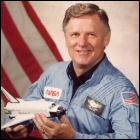 Don Lind, a veteran of the Apollo, Skylab and space shuttle eras at NASA, dies at the age of 92. Born in Midvale, Utah, his service as a U.S. Navy pilot and a degree in nuclear physics brought him to the attention of NASA, and he was a member of the agency’s fifth astronaut class, many of whom went to the moon. Lind was considered for the crew of Apollo 20 until that mission’s cancellation. During the Skylab space station’s tenure, he was assigned to the crew of the Skylab Rescue contingency mission (which ultimately was deemed unnecessary) and then as a potential member of a fourth Skylab crew, whose mission was also cancelled. By the time Lind made his only spaceflight, aboard the shuttle Challenger in 1985, he had been waiting nearly two decades for a flight. He retired from NASA following his flight, and went on to teach at Utah State University.
Don Lind, a veteran of the Apollo, Skylab and space shuttle eras at NASA, dies at the age of 92. Born in Midvale, Utah, his service as a U.S. Navy pilot and a degree in nuclear physics brought him to the attention of NASA, and he was a member of the agency’s fifth astronaut class, many of whom went to the moon. Lind was considered for the crew of Apollo 20 until that mission’s cancellation. During the Skylab space station’s tenure, he was assigned to the crew of the Skylab Rescue contingency mission (which ultimately was deemed unnecessary) and then as a potential member of a fourth Skylab crew, whose mission was also cancelled. By the time Lind made his only spaceflight, aboard the shuttle Challenger in 1985, he had been waiting nearly two decades for a flight. He retired from NASA following his flight, and went on to teach at Utah State University.
Richard Clifford, astronaut, dies
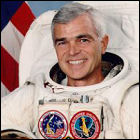 Space shuttle astronaut Richard “Rich” Clifford, who flew three shuttle missions in the 1990s, dies at the age of 69 from complications related to Parkinson’s Disease. A Lieutenant Colonel when he retired from the U.S. Army in 1995, Clifford had been working at NASA while still with the Army, beginning his involvement with the space program in 1987. He helped to certify crew escape systems in the wake of the Challenger disaster, before moving on to assist in the design of EVA equipment in the early 90s. He flew as a mission specialist on the STS-53, STS-59, and STS-76 missions, accumulating over 600 hours in space, including an EVA lasting six hours at the Mir space station on his final flight. It was before that third mission that he was diagnosed with Parkinson’s, but he kept that diagnosis private until after the mission. He retired from NASA in 1997, but joined Boeing as its Flight Operations Manager from the construction of the International Space Station until the final shuttle mission to the ISS in 2011. He also worked with the Michael J. Fox Foundation, which funds research into Parkinson’s.
Space shuttle astronaut Richard “Rich” Clifford, who flew three shuttle missions in the 1990s, dies at the age of 69 from complications related to Parkinson’s Disease. A Lieutenant Colonel when he retired from the U.S. Army in 1995, Clifford had been working at NASA while still with the Army, beginning his involvement with the space program in 1987. He helped to certify crew escape systems in the wake of the Challenger disaster, before moving on to assist in the design of EVA equipment in the early 90s. He flew as a mission specialist on the STS-53, STS-59, and STS-76 missions, accumulating over 600 hours in space, including an EVA lasting six hours at the Mir space station on his final flight. It was before that third mission that he was diagnosed with Parkinson’s, but he kept that diagnosis private until after the mission. He retired from NASA in 1997, but joined Boeing as its Flight Operations Manager from the construction of the International Space Station until the final shuttle mission to the ISS in 2011. He also worked with the Michael J. Fox Foundation, which funds research into Parkinson’s.
Owen K. Garriott, astronaut, dies
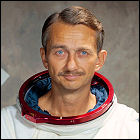 Skylab and Space Shuttle astronaut Owen K. Garriott dies at the age of 88. Born in Oklahoma, former U.S. Navy electronics officer Garriott went on to Stanford University to pursue a doctorate, and returned to Stanford to teach physics and electronics until 1965, when he was selected by NASA as one of the first “scientist astronauts” for future Apollo and Apollo Applications Program missions. (Only one scientist astronaut, Harrison Schmitt, flew to the moon before the Apollo program’s budgetary lunar wings were clipped by the Nixon administration.) Garriott first flew to space in 1973 as part of the second Skylab long-duration crew, staying in orbit for a record-setting two months with his two crewmates, and flew as a mission specialist aboard the first Space Shuttle mission to carry the Spacelab laboratory module into orbit in 1983. Both before and after his second and final flight, he was involved in consulting on the ever-changing design for a planned space station, which, after many changes, evolved into the International Space Station. He was the father of Richard Garriott, designer of the Ultima computer adventure game series who later visited the ISS as a space tourist aboard a Soyuz flight; they were the first father/son astronauts in America (preceded only by cosmonauts Alexander and Sergei Volkov).
Skylab and Space Shuttle astronaut Owen K. Garriott dies at the age of 88. Born in Oklahoma, former U.S. Navy electronics officer Garriott went on to Stanford University to pursue a doctorate, and returned to Stanford to teach physics and electronics until 1965, when he was selected by NASA as one of the first “scientist astronauts” for future Apollo and Apollo Applications Program missions. (Only one scientist astronaut, Harrison Schmitt, flew to the moon before the Apollo program’s budgetary lunar wings were clipped by the Nixon administration.) Garriott first flew to space in 1973 as part of the second Skylab long-duration crew, staying in orbit for a record-setting two months with his two crewmates, and flew as a mission specialist aboard the first Space Shuttle mission to carry the Spacelab laboratory module into orbit in 1983. Both before and after his second and final flight, he was involved in consulting on the ever-changing design for a planned space station, which, after many changes, evolved into the International Space Station. He was the father of Richard Garriott, designer of the Ultima computer adventure game series who later visited the ISS as a space tourist aboard a Soyuz flight; they were the first father/son astronauts in America (preceded only by cosmonauts Alexander and Sergei Volkov).
Piers Sellers, astronaut, dies
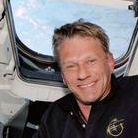 British-born shuttle astronaut Piers Sellers dies of pancreatic cancer at the age of 61. A veteran of over 559 hours in space as a crew member of shuttle missions STS-112, STS-121 and STS-132, Sellers was trained as a meteorologist and did much of his research on climate change, eventually becoming NASA’s acting director of Earth sciences after retiring from flight duty.
British-born shuttle astronaut Piers Sellers dies of pancreatic cancer at the age of 61. A veteran of over 559 hours in space as a crew member of shuttle missions STS-112, STS-121 and STS-132, Sellers was trained as a meteorologist and did much of his research on climate change, eventually becoming NASA’s acting director of Earth sciences after retiring from flight duty.
Atlantis retired
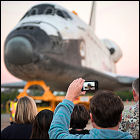 Stripped of critical working systems and engines after her final landing, Space Shuttle Atlantis is moved via a ground transport to a new shuttle museum exhibit at the Kennedy Space Center Visitors’ Center at Cape Canaveral. Having flown 33 times, Atlantis was the last shuttle to travel in space, having returned from orbit the final time in July 2011. Originally intended to be the last addition to the shuttle fleet, construction on Atlantis began in 1980, and was completed in time for Atlantis’ maiden voyage in 1985.
Stripped of critical working systems and engines after her final landing, Space Shuttle Atlantis is moved via a ground transport to a new shuttle museum exhibit at the Kennedy Space Center Visitors’ Center at Cape Canaveral. Having flown 33 times, Atlantis was the last shuttle to travel in space, having returned from orbit the final time in July 2011. Originally intended to be the last addition to the shuttle fleet, construction on Atlantis began in 1980, and was completed in time for Atlantis’ maiden voyage in 1985.
Endeavour retired
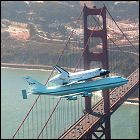 NASA donates the retired Space Shuttle Endeavour, stripped of working engines and other vital equipment, to the California Science Center in Los Angeles. The last shuttle to be built, construction on Endeavour began in 1988 from spare parts to replace the destroyed Challenger; Endeavour lifted off for the first time in 1992, ultimately flying 25 missions, including many of the International Space Station construction missions. This also marks the final flight of the modified Boeing 747 shuttle carrier aircraft, which flew for the first time in 1977.
NASA donates the retired Space Shuttle Endeavour, stripped of working engines and other vital equipment, to the California Science Center in Los Angeles. The last shuttle to be built, construction on Endeavour began in 1988 from spare parts to replace the destroyed Challenger; Endeavour lifted off for the first time in 1992, ultimately flying 25 missions, including many of the International Space Station construction missions. This also marks the final flight of the modified Boeing 747 shuttle carrier aircraft, which flew for the first time in 1977.
Enterprise re-retired
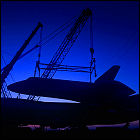 Having already been donated to the Smithsonian Air & Space Museum in 1985, Space Shuttle Enterprise, a test vehicle not built to spaceflight specs, is removed from the custom-made hangar at the Smithsonian and prepared for re-gifting. With NASA donating the space-flown shuttle Discovery to the Smithsonian, Enterprise will now become a major display at New York City’s Intrepid Museum, based on the retired aircraft carrier U.S.S. Intrepid. For the first time in nearly 20 years, Enterprise is loaded onto one of the modified Boeing 747s from which it made its in-atmosphere test flights in 1977 and is transported to New York.
Having already been donated to the Smithsonian Air & Space Museum in 1985, Space Shuttle Enterprise, a test vehicle not built to spaceflight specs, is removed from the custom-made hangar at the Smithsonian and prepared for re-gifting. With NASA donating the space-flown shuttle Discovery to the Smithsonian, Enterprise will now become a major display at New York City’s Intrepid Museum, based on the retired aircraft carrier U.S.S. Intrepid. For the first time in nearly 20 years, Enterprise is loaded onto one of the modified Boeing 747s from which it made its in-atmosphere test flights in 1977 and is transported to New York.
Discovery retired
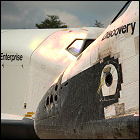 Having completed its last mission, Space Shuttle Discovery is retired, stripped of working engine parts and other items, and donated to the Smithsonian Air & Space Museum by NASA. The workhorse of the shuttle fleet, Discovery flew in space 39 times starting in 1984, visiting both Mir and the International Space Station, and racking up a cumulative total of an entire year in orbit. Discovery takes the place of the test orbiter, Enterprise, which has been on display at the Smithsonian since the 1980s.
Having completed its last mission, Space Shuttle Discovery is retired, stripped of working engine parts and other items, and donated to the Smithsonian Air & Space Museum by NASA. The workhorse of the shuttle fleet, Discovery flew in space 39 times starting in 1984, visiting both Mir and the International Space Station, and racking up a cumulative total of an entire year in orbit. Discovery takes the place of the test orbiter, Enterprise, which has been on display at the Smithsonian since the 1980s.
STS-135: final flight of the Space Shuttle
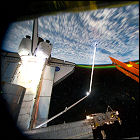 Space Shuttle Atlantis lifts off on the 135th and final flight of an American Space Shuttle. During the 13-day mission to the International Space Station, the final shuttle-sized supply delivery takes place. The mission was originally budgeted as a rescue flight for the final Hubble Space Telescope servicing flight in 2009, but is approved as a final station flight since funding and supplies had already been set aside. Atlantis’ 33rd and final crew is Commander Chris Ferguson, Pilot Doug Hurley, and mission specialists Rex Walheim and Sandy Magnus. Upon landing at Kennedy Space Center for the final time, Atlantis joins the other orbiters in a months-long process to strip them of working engines and other key components before the shuttles are delivered to their museum destinations.
Space Shuttle Atlantis lifts off on the 135th and final flight of an American Space Shuttle. During the 13-day mission to the International Space Station, the final shuttle-sized supply delivery takes place. The mission was originally budgeted as a rescue flight for the final Hubble Space Telescope servicing flight in 2009, but is approved as a final station flight since funding and supplies had already been set aside. Atlantis’ 33rd and final crew is Commander Chris Ferguson, Pilot Doug Hurley, and mission specialists Rex Walheim and Sandy Magnus. Upon landing at Kennedy Space Center for the final time, Atlantis joins the other orbiters in a months-long process to strip them of working engines and other key components before the shuttles are delivered to their museum destinations.
STS-134: Endeavour’s final flight
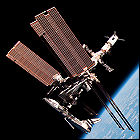 Space Shuttle Endeavour lifts off on its final flight into orbit, carrying an alpha magnetic spectrometer instrument and supplies to the International Space Station during a 16-day mission. This is Endeavour’s 25th and final launch. The crew for this mission consists of Commander Mark Kelly, Pilot Greg Johnson, and mission specialists Mike Fincke, Drew Feustel, Greg Chamitoff and Roberto Vittori.
Space Shuttle Endeavour lifts off on its final flight into orbit, carrying an alpha magnetic spectrometer instrument and supplies to the International Space Station during a 16-day mission. This is Endeavour’s 25th and final launch. The crew for this mission consists of Commander Mark Kelly, Pilot Greg Johnson, and mission specialists Mike Fincke, Drew Feustel, Greg Chamitoff and Roberto Vittori.
Retirement homes for Space Shuttles
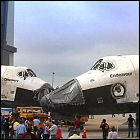 NASA announces the results of a bidding process for soon-to-be-retired Space Shuttle vehicles by institutions across the country. The original test vehicle, Enterprise, will be removed from the Smithsonian and replaced by the space-flown Discovery, while Atlantis will become the centerpiece of a new exhibit at NASA’s own Kennedy Space Center. Endeavour will be handed over to the California Science Museum in Los Angeles, while Enterprise’s new home will be in New York City’s Intrepid Museum. Institutions not selected to receive one of the shuttles, including NASA’s Johnson Space Center in Houston, Texas, almost immediately claim that the selection process has been swayed by politics. None of the vehicles will be transported from Kennedy Space Center to their new locations until the following year.
NASA announces the results of a bidding process for soon-to-be-retired Space Shuttle vehicles by institutions across the country. The original test vehicle, Enterprise, will be removed from the Smithsonian and replaced by the space-flown Discovery, while Atlantis will become the centerpiece of a new exhibit at NASA’s own Kennedy Space Center. Endeavour will be handed over to the California Science Museum in Los Angeles, while Enterprise’s new home will be in New York City’s Intrepid Museum. Institutions not selected to receive one of the shuttles, including NASA’s Johnson Space Center in Houston, Texas, almost immediately claim that the selection process has been swayed by politics. None of the vehicles will be transported from Kennedy Space Center to their new locations until the following year.
STS-133: Discovery’s final flight
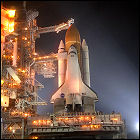 Space Shuttle Discovery lifts off on the 133rd shuttle flight, a 13-day mission add a new (but familiar) module to the International Space Station. One of the logistics modules that has flown in the cargo bay of seven prior shuttle missions is attached to the ISS permanently, adding nearly 2,500 cubic feet of storage space to the facility. Also delivered to the station is Robonaut 2, an experimental robot designed to assist with routine tasks as well as spacewalks. Discovery’s 39th and final crew is Commander Steve Lindsey, Pilot Eric Boe, and mission specialists Alvin Drew, Nicole Stott, Steve Bowen and Michael Barratt.
Space Shuttle Discovery lifts off on the 133rd shuttle flight, a 13-day mission add a new (but familiar) module to the International Space Station. One of the logistics modules that has flown in the cargo bay of seven prior shuttle missions is attached to the ISS permanently, adding nearly 2,500 cubic feet of storage space to the facility. Also delivered to the station is Robonaut 2, an experimental robot designed to assist with routine tasks as well as spacewalks. Discovery’s 39th and final crew is Commander Steve Lindsey, Pilot Eric Boe, and mission specialists Alvin Drew, Nicole Stott, Steve Bowen and Michael Barratt.
STS-132
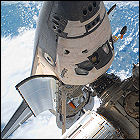 Space Shuttle Atlantis lifts off on the 132nd shuttle flight, a 12-day resupply and maintenance mission to the International Space Station. A “mini research module” built by the Russian space agency is attached to the station, along with cargo and supplies. Upgrades to the station’s solar power arrays are conducted during spacewalks. Aboard Atlantis for her last planned flight (an additional mission will later be scheduled for Atlantis in 2011) are Commander Ken Ham, Pilot Tony Antonelli, and mission specialists Garrett Reisman, Michael Good, Piers Sellers and Steve Bowen. This is the last shuttle flight for over six months.
Space Shuttle Atlantis lifts off on the 132nd shuttle flight, a 12-day resupply and maintenance mission to the International Space Station. A “mini research module” built by the Russian space agency is attached to the station, along with cargo and supplies. Upgrades to the station’s solar power arrays are conducted during spacewalks. Aboard Atlantis for her last planned flight (an additional mission will later be scheduled for Atlantis in 2011) are Commander Ken Ham, Pilot Tony Antonelli, and mission specialists Garrett Reisman, Michael Good, Piers Sellers and Steve Bowen. This is the last shuttle flight for over six months.
STS-131
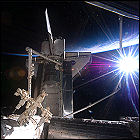 Space Shuttle Discovery is launched on the 131st shuttle flight, a 15-day resupply mission to the International Space Station. Equipment and experiment packages are transferred to the station from a logistics module in the shuttle cargo bay. The joint portion of the flight features the largest female astronaut contingent in orbit at any one time to date, with three of Discovery’s six crewmembers plus station astronaut Tracy Dyson. Aboard Discovery for her 38th flight are Commander Alan Poindexter, Pilot James Dutton, and mission specialists Dorothy Metcalf-Lindenburger, Rick Mastracchio, Naoko Yamazaki, Clayton Anderson and Stephanie Wilson.
Space Shuttle Discovery is launched on the 131st shuttle flight, a 15-day resupply mission to the International Space Station. Equipment and experiment packages are transferred to the station from a logistics module in the shuttle cargo bay. The joint portion of the flight features the largest female astronaut contingent in orbit at any one time to date, with three of Discovery’s six crewmembers plus station astronaut Tracy Dyson. Aboard Discovery for her 38th flight are Commander Alan Poindexter, Pilot James Dutton, and mission specialists Dorothy Metcalf-Lindenburger, Rick Mastracchio, Naoko Yamazaki, Clayton Anderson and Stephanie Wilson.
STS-130
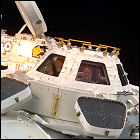 Space Shuttle Endeavour lifts off on the 130th shuttle flight, a 14-day mission to the International Space Station. The Endeavour crew and station astronauts install another module, the Tranquility node, allowing for further expansion of the station in the future; this module also includes the cupola “control tower” that has become visually synonymous with the ISS. Aboard Endeavour for her 24th flight are Commander George Zamka, Pilot Terry Virts, and mission specialists Nicholas Patrick, Stephen Robinson, Robert Behnken and Kathryn Hire.
Space Shuttle Endeavour lifts off on the 130th shuttle flight, a 14-day mission to the International Space Station. The Endeavour crew and station astronauts install another module, the Tranquility node, allowing for further expansion of the station in the future; this module also includes the cupola “control tower” that has become visually synonymous with the ISS. Aboard Endeavour for her 24th flight are Commander George Zamka, Pilot Terry Virts, and mission specialists Nicholas Patrick, Stephen Robinson, Robert Behnken and Kathryn Hire.
STS-129
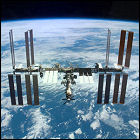 Space Shuttle Atlantis lifts off on the 129th shuttle flight, an 11-day mission to the International Space Station. Equipment, supplies, and spare parts are delivered, enough to make in-orbit maintenance of the station possible for several years. Aboard Atlantis for her 31st flight are Commander Charles Hobaugh, Pilot Barry Wilmore, and mission specialists Mike Foreman, Leland Melvin, Robert Satcher and Randy Bresnik; ISS crewmember Nicole Stott returns to Earth via Atlantis, and is the last ISS crewmember to return home on a shuttle.
Space Shuttle Atlantis lifts off on the 129th shuttle flight, an 11-day mission to the International Space Station. Equipment, supplies, and spare parts are delivered, enough to make in-orbit maintenance of the station possible for several years. Aboard Atlantis for her 31st flight are Commander Charles Hobaugh, Pilot Barry Wilmore, and mission specialists Mike Foreman, Leland Melvin, Robert Satcher and Randy Bresnik; ISS crewmember Nicole Stott returns to Earth via Atlantis, and is the last ISS crewmember to return home on a shuttle.
STS-128
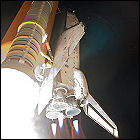 Space Shuttle Discovery lifts off on the 128th shuttle flight, a two-week mission to the International Space Station. Supplies and equipment are delivered to the space station in a cargo-bay-mounted logistics module. Aboard Discovery for her 37th flight are Commander Rick Sturckow, Pilot Kevin Ford, and mission specialists Jose Hernandez, Danny Olivas, Nicole Stott, Christer Fuglesang and Patrick Forrester. Stott remains on the International Space Station, while station crewmember Timothy Kopra returns to Earth aboard the shuttle.
Space Shuttle Discovery lifts off on the 128th shuttle flight, a two-week mission to the International Space Station. Supplies and equipment are delivered to the space station in a cargo-bay-mounted logistics module. Aboard Discovery for her 37th flight are Commander Rick Sturckow, Pilot Kevin Ford, and mission specialists Jose Hernandez, Danny Olivas, Nicole Stott, Christer Fuglesang and Patrick Forrester. Stott remains on the International Space Station, while station crewmember Timothy Kopra returns to Earth aboard the shuttle.
STS-127
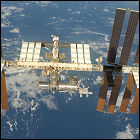 Space Shuttle Endeavour is launched on the 127th shuttle flight, a 16-day mission to the International Space Station to complete the Japanese-built Kibo laboratory facility. The installation of the final Kibo module requires five lengthy spacewalks. Aboard Endeavour for her 23rd flight are Commander Mark Polansky, Pilot Doug Hurley, and mission specialists Christopher Cassidy, Tom Marshburn, Dave Wolf, Julie Payette and Tim Kopra; Kopra remains on the station, with Japanese astronaut Koichi Wakata returning to Earth on the shuttle.
Space Shuttle Endeavour is launched on the 127th shuttle flight, a 16-day mission to the International Space Station to complete the Japanese-built Kibo laboratory facility. The installation of the final Kibo module requires five lengthy spacewalks. Aboard Endeavour for her 23rd flight are Commander Mark Polansky, Pilot Doug Hurley, and mission specialists Christopher Cassidy, Tom Marshburn, Dave Wolf, Julie Payette and Tim Kopra; Kopra remains on the station, with Japanese astronaut Koichi Wakata returning to Earth on the shuttle.
STS-125: last stop at Hubble
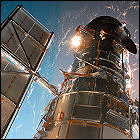 Space Shuttle Atlantis lifts off on the 126th shtutle flight, the final servicing mission to the Hubble Space Telescope (and the only post-Columbia flight not to visit the International Space Station). The repairs and upgrades conducted during a series of spacewalks will extend Hubble’s operation life through at least 2014. Aboard Atlantis for her 30th flight are Commander Scott Altman, Pilot Greg Johnson, and mission specialists John Grunsfeld, Michael Massimino, Andrew Feustel, Michael Good and Megan McArthur. This mission was nearly cancelled in light of post-Columbia flight rules requiring all shuttle flights to visit the space station.
Space Shuttle Atlantis lifts off on the 126th shtutle flight, the final servicing mission to the Hubble Space Telescope (and the only post-Columbia flight not to visit the International Space Station). The repairs and upgrades conducted during a series of spacewalks will extend Hubble’s operation life through at least 2014. Aboard Atlantis for her 30th flight are Commander Scott Altman, Pilot Greg Johnson, and mission specialists John Grunsfeld, Michael Massimino, Andrew Feustel, Michael Good and Megan McArthur. This mission was nearly cancelled in light of post-Columbia flight rules requiring all shuttle flights to visit the space station.
STS-119
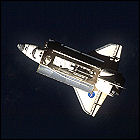 Space Shuttle Discovery lifts off on the 125th shuttle flight, a 13-day mission to the International Space Station. Further spacewalks to repair the station’s solar arrays are conducted, as well as a repair to its on-board water system; with the power and water issues resolved, the station can now house a crew of six astronauts and cosmonauts. Aboard Discovery for her 36th flight are Commander Lee Archambault, Pilot Tony Antonelli, and mission specialists Joseph Acaba, Steve Swanson, Richard Arnold, John Phillips and Koichi Wakata. Wakata stays aboard the station, while ISS crewmember Sandra Magnus returns to Earth aboard Discovery.
Space Shuttle Discovery lifts off on the 125th shuttle flight, a 13-day mission to the International Space Station. Further spacewalks to repair the station’s solar arrays are conducted, as well as a repair to its on-board water system; with the power and water issues resolved, the station can now house a crew of six astronauts and cosmonauts. Aboard Discovery for her 36th flight are Commander Lee Archambault, Pilot Tony Antonelli, and mission specialists Joseph Acaba, Steve Swanson, Richard Arnold, John Phillips and Koichi Wakata. Wakata stays aboard the station, while ISS crewmember Sandra Magnus returns to Earth aboard Discovery.
STS-126
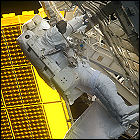 Space Shuttle Endeavour lifts off on a 15-day mission to the International Space Station, carrying more supplies and equipment than any previous shuttle flight bound for the station. Also on tap is a major spacewalk to repair part of the solar panel assembly on the station which allows it to track the sun. Aboard Endeavour for her 22nd flight are Commander Chris Ferguson, Pilot Eric Boe, and mission specialists Steve Bowen, Don Pettit, Shane Kimbrough, Heidemarie Stefanyshyn-Piper and Sandra Magnus. Magnus remains on the International Space Station, while ISS crewmember Greg Chamitoff returns from a six-month stint in space aboard the shuttle.
Space Shuttle Endeavour lifts off on a 15-day mission to the International Space Station, carrying more supplies and equipment than any previous shuttle flight bound for the station. Also on tap is a major spacewalk to repair part of the solar panel assembly on the station which allows it to track the sun. Aboard Endeavour for her 22nd flight are Commander Chris Ferguson, Pilot Eric Boe, and mission specialists Steve Bowen, Don Pettit, Shane Kimbrough, Heidemarie Stefanyshyn-Piper and Sandra Magnus. Magnus remains on the International Space Station, while ISS crewmember Greg Chamitoff returns from a six-month stint in space aboard the shuttle.
STS-124
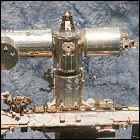 Space Shuttle Discovery is launched on the 123rd shuttle flight, a two-week mission to install a major laboratory module to the International Space Station. The pressurized module of Japan’s Kibo laboratory joins the unpressurized section installed on a previous flight, complete with its own robotic arm controlled inside. Aboard Discovery for her 35th flight are Commander Mark Kelly, Pilot Ken Ham, mission specialists Karen Nyberg, Ron Garan and Mike Fossum, and Japanese astronaut Akihiko Hoshide, who remains on the International Space Station. Station astronaut Garrett Reisman returns to Earth aboard Discovery.
Space Shuttle Discovery is launched on the 123rd shuttle flight, a two-week mission to install a major laboratory module to the International Space Station. The pressurized module of Japan’s Kibo laboratory joins the unpressurized section installed on a previous flight, complete with its own robotic arm controlled inside. Aboard Discovery for her 35th flight are Commander Mark Kelly, Pilot Ken Ham, mission specialists Karen Nyberg, Ron Garan and Mike Fossum, and Japanese astronaut Akihiko Hoshide, who remains on the International Space Station. Station astronaut Garrett Reisman returns to Earth aboard Discovery.
STS-123
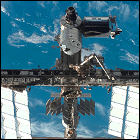 Space Shuttle Endeavour lifts off on the 122nd shuttle flight, a 16 day mission to deliver two new key components of the International Space Station. The unpressurized portion of the Japanese Aerospace Exploration Agency’s Kibo laboratory is delivered and attached, while the two-armed Dextre robotic arm system built in Canada is also installed. Aboard Endeavour for her 21st flight are Commander Dominic Gorie, Pilot Greg Johnson, and mission specialists Garrett Reisman, Robert Behnken, Mike Foreman, Takao Doi and Rick Linnehan. Reisman remains on the ISS, while station astronaut Leopold Eyharts hitches a ride back to Earth aboard the shuttle.
Space Shuttle Endeavour lifts off on the 122nd shuttle flight, a 16 day mission to deliver two new key components of the International Space Station. The unpressurized portion of the Japanese Aerospace Exploration Agency’s Kibo laboratory is delivered and attached, while the two-armed Dextre robotic arm system built in Canada is also installed. Aboard Endeavour for her 21st flight are Commander Dominic Gorie, Pilot Greg Johnson, and mission specialists Garrett Reisman, Robert Behnken, Mike Foreman, Takao Doi and Rick Linnehan. Reisman remains on the ISS, while station astronaut Leopold Eyharts hitches a ride back to Earth aboard the shuttle.
STS-122
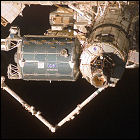 Space Shuttle Atlantis lifts off on the 121st shuttle flight, a 13-day mission to deliver another laboratory module to the International Space Station. The European Space Agency’s Columbus lab module is ESA’s contribution to the station, and is attached to the recently-installed Harmony node over the course of three spacewalks. Aboard Atlantis for her 29th flight are Commander Steve Frick, Pilot Alan Poindexter, and mission specialists Stanley Love, Leland Melvin, Rex Walheim and Hans Schlegel. ISS Expedition 17 crewmember Leopold Eyharts travels to the station aboard Atlantis, while ISS Expedition 16 crewmember Daniel Tani returns to Earth on the shuttle in his place.
Space Shuttle Atlantis lifts off on the 121st shuttle flight, a 13-day mission to deliver another laboratory module to the International Space Station. The European Space Agency’s Columbus lab module is ESA’s contribution to the station, and is attached to the recently-installed Harmony node over the course of three spacewalks. Aboard Atlantis for her 29th flight are Commander Steve Frick, Pilot Alan Poindexter, and mission specialists Stanley Love, Leland Melvin, Rex Walheim and Hans Schlegel. ISS Expedition 17 crewmember Leopold Eyharts travels to the station aboard Atlantis, while ISS Expedition 16 crewmember Daniel Tani returns to Earth on the shuttle in his place.
STS-120
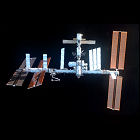 Space Shuttle Discovery lifts off on the 120th shuttle flight, a 15-day mission to deliver a new module to the International Space Station. The module in question is the Harmony node, which adds space for further modules to be added by future shuttle missions. Aboard Discovery for her 34th mission are Commander Pamela Melroy, Pilot George Zamka, mission specialists Douglas Wheelock, Scott Parazynski, Stephanie Wilson and Paolo Nespoli, and ISS Expedition 16 crewmember Daniel Tani, who remains on the station. Among the items stowed away aboard the shuttle are the screen-used lightsaber prop wielded by Luke Skywalker in Return Of The Jedi.
Space Shuttle Discovery lifts off on the 120th shuttle flight, a 15-day mission to deliver a new module to the International Space Station. The module in question is the Harmony node, which adds space for further modules to be added by future shuttle missions. Aboard Discovery for her 34th mission are Commander Pamela Melroy, Pilot George Zamka, mission specialists Douglas Wheelock, Scott Parazynski, Stephanie Wilson and Paolo Nespoli, and ISS Expedition 16 crewmember Daniel Tani, who remains on the station. Among the items stowed away aboard the shuttle are the screen-used lightsaber prop wielded by Luke Skywalker in Return Of The Jedi.
STS-118 puts a teacher in space
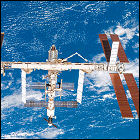 Space Shuttle Endeavour lifts off on the 119th shuttle flight, a 12-day mission to the International Space Station. Additional truss sections are delivered and installed at the station to support solar power arrays, along with the delivery of 5,000 pounds of supplies, consumables and experiments. Aboard Endeavour for her 20th flight are Commander Scott Kelly, Pilot Charles Hobaugh, and mission specialists Richard Mastracchio, Dr. Dafydd Williams, Barbara Morgan, Dr. Tracy Caldwell and Benjamin Drew. Morgan is the first Teacher In Space, having been Christa McAuliffe’s backup in the 1980s, finally fulfilling the Teacher In Space program after 21 years.
Space Shuttle Endeavour lifts off on the 119th shuttle flight, a 12-day mission to the International Space Station. Additional truss sections are delivered and installed at the station to support solar power arrays, along with the delivery of 5,000 pounds of supplies, consumables and experiments. Aboard Endeavour for her 20th flight are Commander Scott Kelly, Pilot Charles Hobaugh, and mission specialists Richard Mastracchio, Dr. Dafydd Williams, Barbara Morgan, Dr. Tracy Caldwell and Benjamin Drew. Morgan is the first Teacher In Space, having been Christa McAuliffe’s backup in the 1980s, finally fulfilling the Teacher In Space program after 21 years.
STS-117
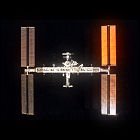 Space Shuttle Atlantis lifts off the 118th shuttle flight, on a two-week mission to resupply and continue assembly of the International Space Station. Two major structural trusses and two large solar power arrays are delivered and installed, and a damaged array is removed. Aboard Atlantis for her 28th flight are Commander Rick Sturckow, Pilot Lee Archambault, and mission specialists Patrick Forrester, Danny Olivas, Clayton Anderson, Jim Reilly and Steven Swanson. Anderson remains on the station, joining the crew of ISS Expedition 15.
Space Shuttle Atlantis lifts off the 118th shuttle flight, on a two-week mission to resupply and continue assembly of the International Space Station. Two major structural trusses and two large solar power arrays are delivered and installed, and a damaged array is removed. Aboard Atlantis for her 28th flight are Commander Rick Sturckow, Pilot Lee Archambault, and mission specialists Patrick Forrester, Danny Olivas, Clayton Anderson, Jim Reilly and Steven Swanson. Anderson remains on the station, joining the crew of ISS Expedition 15.
STS-116
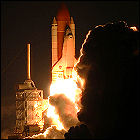 Space Shuttle Discovery returns to the International Space Station to add another major structural truss, resupply the station, and swap crew members. During this flight, the 75th spacewalk involving station construction takes place, moving part of the station’s solar power apparatus to another part of the station. Aboard Discovery for this flight are Commander Mark Polansky, Pilot William Oefelein, and mission specialists Robert Curbeam, Joan Higginbotham, Nicholas Patrick, Christer Fuglesang and Sunita Williams, who will stay on the International Space Station as its new flight engineer. Returning with Discovery is Thomas Reiter, who was flown to the station aboard Discovery in July.
Space Shuttle Discovery returns to the International Space Station to add another major structural truss, resupply the station, and swap crew members. During this flight, the 75th spacewalk involving station construction takes place, moving part of the station’s solar power apparatus to another part of the station. Aboard Discovery for this flight are Commander Mark Polansky, Pilot William Oefelein, and mission specialists Robert Curbeam, Joan Higginbotham, Nicholas Patrick, Christer Fuglesang and Sunita Williams, who will stay on the International Space Station as its new flight engineer. Returning with Discovery is Thomas Reiter, who was flown to the station aboard Discovery in July.
STS-115
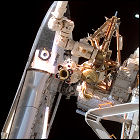 Space Shuttle Atlantis lifts off for its first spaceflight, and the first normal International Space Station construction mission, in four years. A new truss section with more 240-foot solar power panels is added to the station over the course of three spacewalks, each lasting at least six hours. Aboard Atlantis for this flight are Commander Brent Jett, Pilot Christopher Ferguson, and mission specialists Heidemarie Stefanyshyn-Piper, Joe Tanner, Daniel Burbank, and Steven MacLean.
Space Shuttle Atlantis lifts off for its first spaceflight, and the first normal International Space Station construction mission, in four years. A new truss section with more 240-foot solar power panels is added to the station over the course of three spacewalks, each lasting at least six hours. Aboard Atlantis for this flight are Commander Brent Jett, Pilot Christopher Ferguson, and mission specialists Heidemarie Stefanyshyn-Piper, Joe Tanner, Daniel Burbank, and Steven MacLean.
STS-121
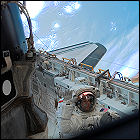 NASA launches Space Shuttle Discovery for the first time in nearly a year for a second “Return to Flight” mission to the International Space Station, testing more safety procedures and new materials developed since the July 2005 flight (which still required repairs to be conducted in orbit). Aboard Discovery are Commander Steven Lindsey, Pilot Mark Kelly, and mission specialists Stephanie Wilson, Michael Fossum, Piers Sellers, Thomas Reiter and Lisa Nowak. Reiter remains aboard the station, bumping its crew up to three people for the first time since 2003.
NASA launches Space Shuttle Discovery for the first time in nearly a year for a second “Return to Flight” mission to the International Space Station, testing more safety procedures and new materials developed since the July 2005 flight (which still required repairs to be conducted in orbit). Aboard Discovery are Commander Steven Lindsey, Pilot Mark Kelly, and mission specialists Stephanie Wilson, Michael Fossum, Piers Sellers, Thomas Reiter and Lisa Nowak. Reiter remains aboard the station, bumping its crew up to three people for the first time since 2003.